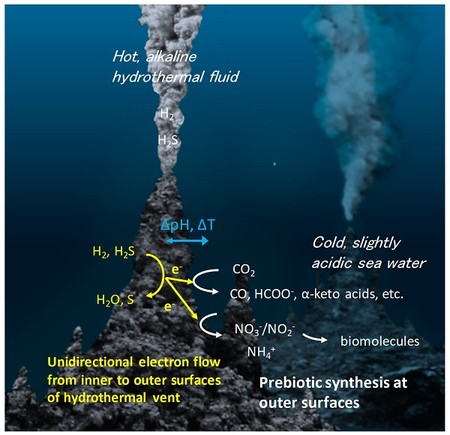Research Highlights
A study by Dr Yamei Li, Prof. Ryuhei Nakamura and Dr Norio Kitadai was published in Life
Chemical Diversity of Metal Sulfide Minerals and its Implications for the Origin of Life
 The model of chemical evolution for origin of life in deep sea hydrothermal vent environment, using metal sulfide mineral as the catalysts. For catalyzing carbon and nitrogen conversion reactions efficiently and selectively, the metal sulfide catalysts should be comprehensively screened.
The model of chemical evolution for origin of life in deep sea hydrothermal vent environment, using metal sulfide mineral as the catalysts. For catalyzing carbon and nitrogen conversion reactions efficiently and selectively, the metal sulfide catalysts should be comprehensively screened.
The origin of life on Earth is generally envisioned as having started from abiotic syntheses of basic building blocks requisite for metabolism and replication. Metal sulfides have been proposed as key players in these prebiotic processes in several scenarios, such as the "iron-sulfur world" by Wächtershäuser, the "iron-sulfur membrane model" by Russell and Hall and more recently by Lane and Martin, the "zinc world" hypothesis by Mulkidjanian and Galperin, and the "geoelectrochemistry driven origin of life" by Nakamura, Yamamoto, and Barge. Metal sulfides are ubiquitous in reducing environments, including sulfidic ores, deep-sea hydrothermal vent deposits, sulfide-rich euxinic sediment environments (e.g., black sea), and black shale. Although several laboratory studies demonstrated the carbon and nitrogen conversion catalyzed by metal sulfides (mainly Fe-S and Ni-S), an inferior activity and selectivity as well as a limited chemical diversity of generated products were typically shown. This problem makes it clear that prebiotic catalysts should be comprehensively screened. Most previous studies utilized limited types of pure and single metal sulfides, which only cover a very small portion of naturally existed metal sulfide minerals.
Here, Dr. Yamei LI, PI Ryuhei Nakamura and Dr. Norio Kitadai from ELSI, evaluated the chemical diversity of mineral catalysts by surveying the metal sulfide mineral species ever discovered in mineralogy database. A wide range of variation in the crystal phase, valence state of metal and sulfur, and the metal compositions was observed. In light of such high chemical diversity of mineral catalysts, they discussed the approaches to rationally predict the catalytic functions of metal sulfides based on advanced theories and analytical tools of electrocatalysis, such as proton-coupled electron transfer, structural comparisons between enzymes and minerals, and in situ spectroscopy.
Moreover, the researchers introduced a model of geoelectrochemistry driven prebiotic synthesis for chemical evolution, and discussed how we can predict kinetics and selectivity of targeted prebiotic chemistry under "chemically messy conditions". It was proposed that combining the data-mining of mineral databases with experimental methods, theories, and machine-learning approaches developed in the field of electrocatalysis will facilitate the prediction and verification of catalytic performance under a wide range of pH and Eh conditions, and will aid in the rational screening of mineral catalysts involved in the origin of life. As the organic synthesis on metal sulfides has long been the subject of intensive research in prebiotic chemistry and astrobiology, this review can provide a new and important perspective to explore the coevolution of life and Earth.
| Journal | Life |
| Title of original paper | Chemical Diversity of Metal Sulfide Minerals and Its Implications for the Origin of Life |
| Authors | Yamei LI 1*, Norio Kitadai1, Ryuhei Nakamura 1,2* |
| Affiliations | 1.Earth-Life Science Institute, Tokyo Institute of Technology 2. Biofunctional Catalyst Research Team, RIKEN Center for Sustainable Resource Science |
| DOI | 10.3390/life8040046 |
| Online published date | October 10, 2018 |












